-
• #12552
go the black bay, jose. i'm tempted, but then i'd have to stop playing the astronaut every day.
How else do you justify having your vintage snorkel kit in your moodily lit city center man cave?!
-
• #12554
Anyone diving off Manhattan is either looking for bodies or doing a turd census!
-
• #12555
crotch explodes
Hip replacement fucked again?
-
• #12556
Heh, that or the colostomy bag.
-
• #12557
turd census!
Think I saw them at the Old Blue Last
-
• #12558
Tudor confuses me and polarises opinions.
I'm prob just about to splash out on a black bay but every now and again a little voice in my head says "its just a Rolex with an ETA movement in".
There are a lot of good value watches out there with ETA movements in. You could buy the whole range of Steinharts with ETA movements in until their supply dried up and they ended up having to develop their own movement (the ST5). I don't think this is a coincidence. I reckon Tudor see the Steinharts of the world as their biggest rivals and are throwing their weight about to smother them.
Alsal had a handful of ETA based GMT watches made a while back and I was really impressed with the build quality and finish but I just couldn't face parting with over a grand for a watch with a movement in that you can buy in watches for less than £500.
That said, the Tudor urge is strong in me.
Hope this helps:
Smoke and Mirrors - part 1 (ETA grades explained)
We all learn early on in our watch collecting careers that it's common practice for companies to rename an ETA movement with their own model number after they modify it. It's an exercise that's been going on for years with more than just ETA products. Longines used Valjoux 72 chronograph movements under their code of 330 or 332, Cyma 380 automatics were renamed the Longines 480, and Marvin 700 series became their caliber 490. Omega used a Lemania chronograph movement for their famous calibers 321 and 861, and still use one as a base for their modern 1861. Breitling also employs Lemania movements for some of their modern manual wind watches, calling it the B12; they also used various Valjoux chronographs including the Valjoux 72 in their early Navitimers. So it's a fact that many brands are using 'customized' ETA movements inside their watches nowadays..... but what do they really do to upgrade them? Let's have a look.Valjoux 7736 inside a vintage Breitling
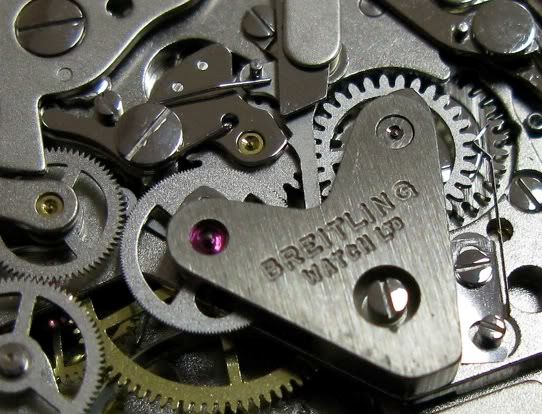
But before we get into individual companies and movements, there's some basic information you need to know. ETA sells their ebauchés in 4 grades, and not all of the grades are offered for every movement. They are Standard, Elaboré, Top, and Chronometre. The Valjoux 7750 does not come in the Standard Grade. Each grade has set performance parameters, and 95% of the ebauchés delivered in a lot must be within these limits.
Standard
- adjusted in 2 positions: CH and 6H (click HERE for details on positional timekeeping terminology)
- average daily rate: +/- 12 seconds
- maximum positional variation: 30 seconds
- isochronism between 0 and 24 hours: +/- 20 seconds
Elaboré
- adjusted in 3 positions: CH, 6H, 9H
- average daily rate: +/- 7 seconds
- maximum positional variation: 20 seconds
- isochronism between 0 and 24 hours: +/- 15 seconds
Top
- adjusted in 5 positions: CH, FH, 6H, 9H, 3H
- average daily rate: +/- 4 seconds
- maximum positional variation: 15 seconds
- isochronism between 0 and 24 hours: +/- 10 seconds
Chronometre
- adjusted and timed per COSC specification (see above link under Standard) which is not much different from Top Grade
There are also upgraded parts made with different alloys and materials in the higher grades. The Standard and Elaboré calibers use Etachoc shock protection, a nickel balance wheel with a Nivarox 2 alloy hairspring, a Nivaflex NO mainspring, a steel pallet lever and escape wheel, and polyruby pallet jewels. The Top and Chronometre calibers use Incabloc shock protection, a Glucydur balance wheel with an Anchron alloy hairspring, a Nivaflex NM mainspring, a Nivarox pallet lever and escape wheel, and ruby pallet jewels.
Explaining the advantage of a Glucydur balance over a nickel balance is simple: Glucydur (or beryllium bronze) resists deformation from temperature change or abuse much better than nickel so the balance wheel stays in balance and therefore keeps more consistent time.
Glucydur balance wheel
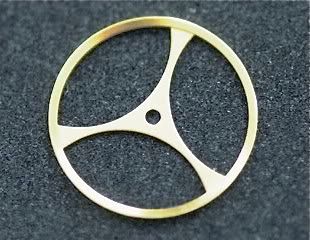
As far as the hairspring materials, there are 5 Nivarox versions - 1 being the highest grade, 5 being the lowest. The difference lies in the consistency of the timekeeping performance due to small changes in the alloyed metals. Nivarox hairsprings consist of cobalt (42-48%), nickel (15-25%), chromium (16-22%), and small amounts of titanium and beryllium. Anachron is said to be a better performing alloy than any Nivarox incarnation which is why it's used on the Top and Chronometre grades. What metals Anachron consists of is another mystery. I've asked watchmakers here and in the real world and searched the internet for days without finding any information. ETA does also offer the option to upgrade from a Niravox 2 to a Niravox 1 hairspring with the nickel balance wheel on the lower two grades. (click HERE and HERE for more information on the balance & hairsping assembly)
Explaining the variance between Nivaflex NO and Nivaflex NM mainsprings is more difficult - the alloy formulation changes are a trade secret so information is scarce even to watchmakers. I'm not sure if there is much of a change between the two since both Nivarox alloys are listed as 45% cobalt, 21% nickel, 18% chromium, 5% iron, 4% tungsten, 4% molybdenum, and 1% titanium. Do the math and that leaves 2% unaccounted for and who knows what elements fill that void. The difference in the NO and NM might only be tempering the end of the spring and bridle, but that would be an educated guess. (click HERE for more information on mainsprings)
The difference between polyrubies and rubies is based in the manufacturing process. Polyrubies are made from powder that's heat pressed into shape. They're translucent, almost foggy. Rubies are cut from a man-made crystal that's formed in an electro-chemical process. They're completely transparent with better consistency. (click HERE and HERE for more on jewels and shock protection)
The change in shock protection from Etachoc to Incabloc is mostly about price. Incabloc costs more... but for a good reason. The Incabloc system is made entirely to in-house parameters instead of assembled from off the shelf pieces which is a real advantage on the quality control front. Even the jewels are custom made by Sietz (who have practically monopolized the jewel making industry) to Incabloc's specifications. It's also easier to service the Incabloc system. ETA does offer an upgrade to Incabloc on Standard and Elaboré calibers.
.Etachoc vs Incabloc
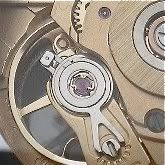
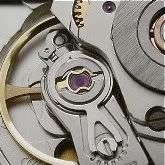
pictures by Johnny PIf you're curious, you can see illustrations of the dozens of different shock protection systems HERE.
If any watchmaker or other industry insider would like to clue us in on some of the other secretive alterations in materials we'd certainly like to hear from you.
I've picked out some of what I thought was the best comment- but I think it's worth going through yourselves
Does anyone really think that an Omega 7750, or an IWC 7750, or an ETA Chronometer 7750, or (insert chronometer brand here) 7750, are significantly different? And of course, since Omega and ETA are brothers, everyone knows that both of their 7750's come off the same bench, whether they say Omega or ETA.
If you're going to reveal in Part 2 that Breitling and IWCs, etc, come straight out of ETAs shop as chronometers, too, that shouldn't be all that surprising either. After all, how much can any brand really modify them? This isn't rocket science!
Truth is, it's part of the reason I don't own an IWC Spitfire Chrono, but instead own an Omega Speedmaster Date Chronometer; they both have essentially the same specs and I ask myself, "how different could the 7750s be?" (btw - I LOVE the spitfires, just struggle with the price difference)
Now, if IWC were casing up base 7750s and calling them "modified", THAT would be news (involving smoke and mirrors and deception).
Smoke and Mirrors - part 2 (ETA "modifications & upgrades")
Now that we got the basic information out of the way in THIS THREAD, let's get into a few specifics.First up, the Valjoux 7750. It's the most common automatic chronograph on the market by a wide margin. Longines calls it the caliber L644, L674, or L678. Most of Oris' 67x and 68x series are based on some derivative of the 775x family. Omega dubs it the caliber 1154, 1164 or 3600. Breitling calls it the caliber B13 or B20, of which the B13 will be our example. Here's a picture of my Chrono Cockpit's movement:
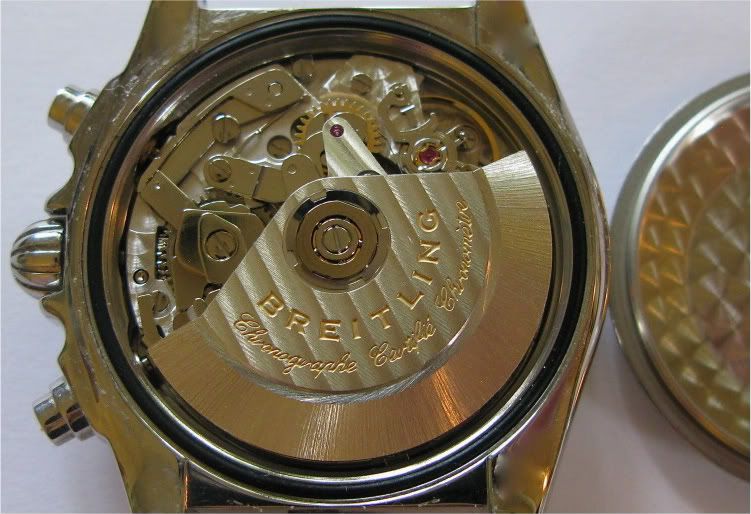
Looks pretty good, huh? Who wouldn't like the perlage on the plates and Geneva stripes on the rotor? Breitling probably stripped that ebauché to the bone and refinished it, right? WRONG!!! Have a look at the options ETA offers on the 7750:
http://www.eta.ch/d/produkte/Mecalin...decors_eta.pdf
Did you notice the perlage and Geneva stripes are available directly from ETA on the 7750? It's on page 3 - option 11 with a close up in the last picture of page 4. All Breitling did was engrave their name on the rotor. Omega isn't much better when it comes to this movement - compare the options available with their caliber 1164 in this link from Ranfft's database: bidfun-db Omega_1164: Omega 1164 (Valjoux 7750). They engraved and reshaped the rotor - that's it.
Do you remember how we all drooled over the Christopher Ward Speedhawk when it was announced?

Wow, blued screws and everything! They must have put quite an effort into spiffing that beauty up. Not so fast - go back and look at the 7750 .pdf file again. Yep, everything on that CW Speedhawk's movement is an option that can be ordered from ETA. Worse yet, the CW and Breitling are in very different price brackets so it makes it tough to justify the added expense for some 7750 based watches. There are manufacturers who do some serious modification to the 7750 though. IWC does quite a bit of work to it for their watches, especially the calendar pieces.... but they're the exception that proves the rule. For information about the modifications, read THIS and then THIS (thanks to Dr.Brian for digging up the second one). They replace the majority of the drive train (mainspring and barrel, wheel train, balance wheel, escape lever, etc) as well as extensive refinishing to make a more efficient caliber.
How about the 2892? Again, many brands use this movement. Breitling has a number of calibers based on it with chronograph or calendar modules attached. Longines calls it the L614 or L619, Omega names it the 1120 and after retrofitting the co-axial escapement calls it the 2500, and Ulysse Nardin has several calibers based on it including the UN-13. Here's a picture of a Tiffany's Mark Coupe in stainless steel powered by a 2892-A2:
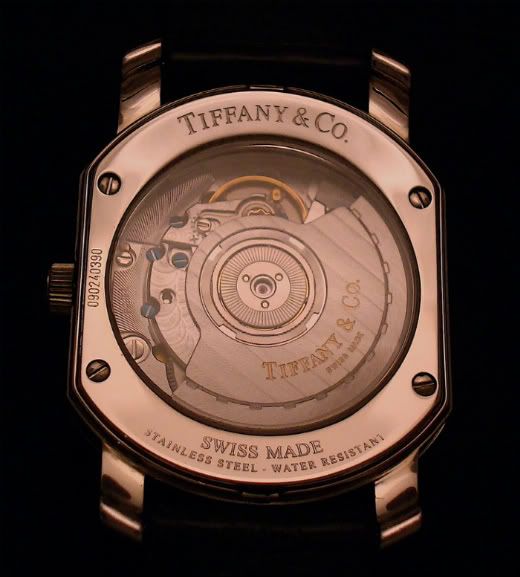
You would think a company that's got over a century of experience finishing high-end jewelry would work wonders on a watch movement. Nope! Most of the same options offered for the 7750 are available for the 289x series, plus a few fancier ones. Here's the .pdf file from ETA:
http://www.eta.ch/d/produkte/Mecalin...decors_eta.pdf
Now take a look at the UN-26 and compare it to the ETA options in the above link:
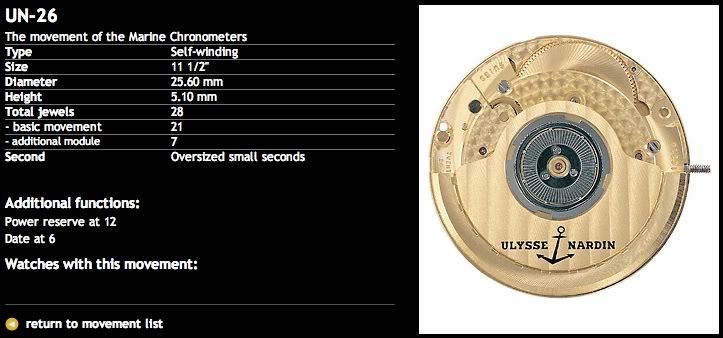
If you didn't see the ETA .pdf, you'd think that was a labor intensive job to create a movement that gorgeous, wouldn't you? Not after seeing it can be ordered exactly like that from ETA amongst the options on page 4 and 5! The 7 extra jewels are in the power reserve module that's attached to the movement, not added to the actual 2892. UN claims that 58 extra parts are added, but doesn't say how many are actually added to improve the 2892 if any at all, nor how many are in the module that's attached. UN isn't the only high-end brand guilty of this either; they're just a typical example. Many companies who charge thousands of dollars for their watches still use a movement right out of the box (with a little regulation for timekeeping's sake).
Let's take a look at Omega now. The caliber 1120 used in the older Seamaster Professional series is an ETA 2892-A2 with 2 jewels added to the ends of the barrel arbor. Omega also reshaped the automatic winding system's bridge to increase the winding efficiency and decrease rotor wobble over their previous version called the 1109. The updated caliber 2500 "C" version has George Daniel's co-axial escapement. There are 4 extra jewels in the escapement bringing the total to 27.
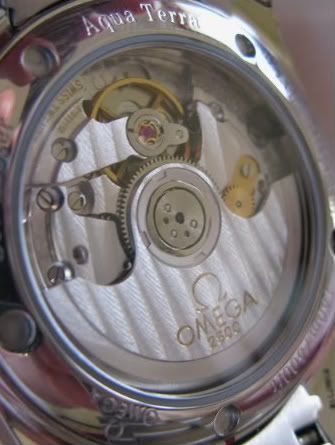
Omega took a proven commodity in the 1120 and modified it by reshaping some plates & bridges to squeeze the new escapement into it, and decreased the beats per hour from 28,800 to 25,200 after some initial trouble at the higher rate because the co-axial was engineered to run at slower speeds. Kudos to Omega for actually doing some improvements to the base ETA ebauché though, because they certainly don't to some - like the 1164 based on the Valjoux 7750. They also had to do some minor changes to the wheel train to change the ratios to slow the bph. You also have to like how Omega reshaped the rotor to resemble their classic calibers from the 60's on all the ETA movements they use. One big drawback is the number of complaints about the 2500 stopping for no reason. Due to the shape of the escape lever's end, it has a tendency to overbank and stop the watch cold. Daniels designed the co-axial to work between 18,000 bph and 21,600 bph - but that's a subject for a different thread. (drawings of the co-axial are HERE - scroll down and you can see that if the tail end of the lever hops over a banking pin it would lock and freeze the whole assembly) We won't go into details, but there were 3 versions of the 2500 due to lubrication and other problems. There was some interesting discussion related to it last March HERE and HERE (please forgive the banal automotive analogies, and feel free to search the Omega Forum for more threads relating to the caliber 2500 and it's pratfalls). Keep your fingers crossed that the new caliber 8500, which was engineered from the ground up to work with the co-axial escapement, has resolved the issues.
Of course the derivatives of the base 2892 are also subject to the same practices. Here's a Tag Heuer Carrera Twin Time with the ETA 2893 GMT movement inside, in this case called the Caliber 7:
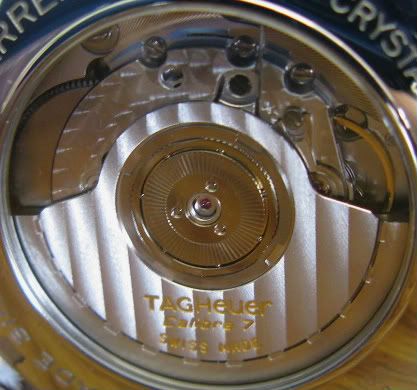
The exception to the rule is again IWC. From an article in WatchTime dating to December of 2002 comes information that IWC does similar upgrades to the 2892-A2 as they do to the 7750 to abate friction, tighten tolerances, and increase efficiency.
And now for the 2824 - the rugged workhorse in ETA's stable; built with thicker plates & bridges to be sturdier than the rest of their movements. This caliber is employed in many dive/sport watches by hundreds of brands both large and small. It's dubbed the L633 or L635 when Longines installs it in their products. There are several clones of it too, the most popular being the Sellita SW-200 which Oris uses as the caliber 633, 637, and 654. Some companies, like Christopher Ward, often interchange the 2824 and SW-200 in the same model watches. As tough as it is, the 2824 is not immune from the horological equivalent to blush and eyeliner as you can see in the .pdf file:
http://www.eta.ch/d/produkte/Mecalin...decors_eta.pdf
So to the original question of "what do companies do to upgrade / modify ETA ebauchés?" the answer in the majority of cases is "barely anything!". From what I've also been told, Swatch Group (owners of ETA) will even do some further customization to their movements for an extra charge. Or a company could simply buy out a smaller movement manufacturer, change their name, and have them produce "in-house" movements for the brand - like Carl F. Bucherer did in 2007 when they bought Techniques Horlogères Appliquées SA or like Vacheron Constantin did in 1998 with the acquisition of Haut de Gamme. There's more than one way to skin a cat.
While some veterans might already be aware of most of these bogus "upgrades", many newer members believe the renamed ETA movements are actually in-house calibers made by the offending brands. So let's here what you have to say - questions and comments are not only welcome, they're encouraged.
Apologies for some of the dead links. I will be asking for archives of the posts
This is the original link for the thread:
http://forums.watchuseek.com/f2/smoke-mirrors-part-2-eta-modifications-upgrades-459866.html
I'd especially advise going through the comments/replies here in part 2 as it's far more meatier!
- adjusted in 2 positions: CH and 6H (click HERE for details on positional timekeeping terminology)
-
• #12559
Things done changed:
Just been talking about this very subject in the pub with horatio and object...
Conclusion? We're all idiots*...
- That is, watch thread people are idiots... Man bracelets as Mrak puts it...
BTW I've never spent more than £160 on a watch...
I didn't realise the Palegos is Ti...
- That is, watch thread people are idiots... Man bracelets as Mrak puts it...
-
• #12560
I didn't realise the Palegos is Ti...
Yessssssssssssssssssssssssss...
-
• #12561
I do think I'm an idiot to want to drop so much coin on something as ephemeral and anachronistic as a mechanical timepiece...
Man bracelet... I'm honest about it tho'...
-
• #12562
^ It is silly but then life is short, we work hard, we invest thousands in things we never see anything for. Life insurance anyone?
So why not splurge on something completely unnecessary but enormously satisfying.
-
• #12563
Describing a watch as ephemeral and a anachronistic is priceless! Thankyou!
Contender for post of the year.
-
• #12564
So why not splurge on something completely unnecessary but enormously satisfying.
Most of the best fucks of my life!
-
• #12565

it starts as a Top grade ETA 2824-2, modified to have KIF shock absorption, and a Triovis fine-adjustment regulator.

Decoration is one thing, but many companies have decoration applied to the higher end 2824-2's for use in chronometer grade watches - Brietling for example.
The Tudor 2824-2's start as Top grade, so they have all the parts that the Chronometer grade movements do, without the actual testing being done. The shock system is then changed from Incabloc to Kif, and they remove the ETACHRON system, and implement a more traditional stud on the balance spring, and traditional regulator pins.
For me as a watchmaker who services these movements, removing the ETACHRON is not an advancement, but a step backwards. Adjusting the centering of the balance spring, the centering of the outer coil through the regulating pins, and setting the spacing of the regulating pins is so much easier with the ETACHRON system, it really makes no technical sense (in my opinion) to remove this system. There's no doubt that a watch can be adjusted just as well using the traditional systems, but is it far less time consuming with the ETACHRON system. I suspect the Rolex does this because they want to make it their own, and not for any technical reason.
Hope this helps.
Cheers, Al
-
• #12566
Multi, you're reposting something that with more digging you'd find is a guy who has an axe to grind. This poster is well known on WUS and other watch forums.
-
• #12567
Ok, I want this.
http://static.squarespace.com/static/4fa14d3ce4b08a53fa26468e/t/52fbae38e4b0a07e01b8b278/1392225851836/?format=750wSOOOOOOOOO black!!! Love, love, love...
#everythingblack #streetgothWell?
-
• #12568
^^It hasn't put me off too much. I'm all about balance. Is there any info you can add on the movement?
Also what are people's views on Planet Oceans? Are the new one's as good as the older ones (both chrono and non)?
-
• #12569
Ti Spring Drive Seiko:

-
• #12570
Love it. But I wouldn't spunk 5 large on it.
-
• #12571
Funny thing about Seiko and GS in particular but they only give me a semi when vintage.
-
• #12572
^ To clarify, that is a 2 jewel chronological chubby.
-
• #12573
-
• #12574
It makes me fucking sick, not having enough wedge to plop on all the things I want. A gratuitous but tasteful watch, or the Look KG381 Team in classifieds.
My blood ran cold this morning when I realised my watch had stopped for the first time under my ownership. Going back to the sleeping while wearing a watch thing from a few pages back - I used to find it vulgar somehow before trying it and finding I could live with myself the next day if I kept it on. Kicked the habit for a night and the blighter had served notice we can't ever be parted. Thankfully he picked up once it was back on my wrist, but I didn't enjoy seeing him frozen.
-
• #12575
^^Cannot get on with that bezel.
 Multi_Grooves
Multi_Grooves BeauNidle
BeauNidle Olly398
Olly398 Crispin_Glover
Crispin_Glover VanUden
VanUden Stonehedge
Stonehedge TheorySwine
TheorySwine @coppiThat
@coppiThat
They make specific versions for the UAE. The Air Force ones are particularly sought after and change hands for prices that you could buy a very nice car for.